Opinions expressed in this article are those of the sponsor. Search Engine Land neither confirms nor disputes any of the conclusions presented below.
Improve your content’s longevity and ROI with a predictable framework
Apply a strategy to each stage of the content lifecycle to see traffic come in long after you hit publish.

The scramble to create as much new content as possible to see what sticks is outdated and unsustainable.
We’ve all read and heard the laundry list of things to do:
- Write quality content (but how?)
- Refresh your content (where to start?)
- Monitor competitors’ content (what are they updating/launching?)
- Apply search intent (impossible at scale?)
If you are in this situation and still fumbling with these questions, we created a structured framework that will produce a desired content lifecycle to generate predictable ROI with your content investment.
Investment in content marketing isn’t the challenge anymore. Those of us leading SEO want to hone that resource to generate repeatable results.
Luckily, there’s a systematic way to bring longevity and relevancy to your content lifecycle to drive results long after you hit publish.
Content’s arbitrary performance
The graph below shows what we’ve found as the typical content lifecycle stages: Plant, Grow and Decay, with traffic over time.
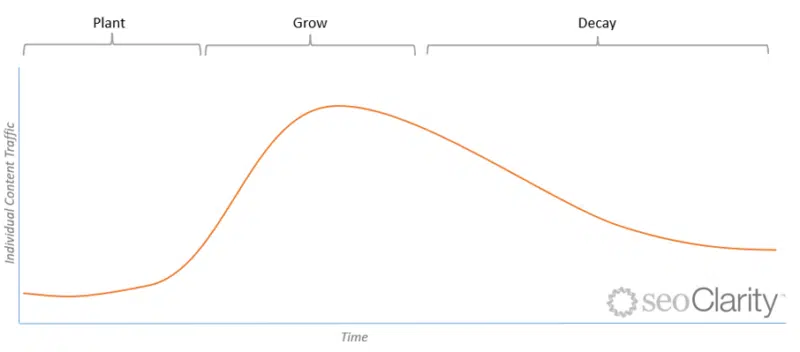
Content is planted (published), it grows (gains rankings and traffic), reaches a peak (growth dependent on many factors), and begins to decay (declines in ranking and traffic due to changes in market, relevance, or competitor efforts).
With enterprises’ content marketing budgets averaging $425k annually, this standard content lifecycle trend can mean a massive loss of investment.
You probably face this challenge, too.
Enterprises need to apply a strategy to each stage to avoid content that reaches its peak and decays.
In our experience with 3,500+ brands, marketers who have applied a structure to content realize a more predictable ROI content model.
Content’s predictable performance
When marketers apply a strategy to each stage of the content lifecycle, they create better content, grow it faster, and prevent decay.
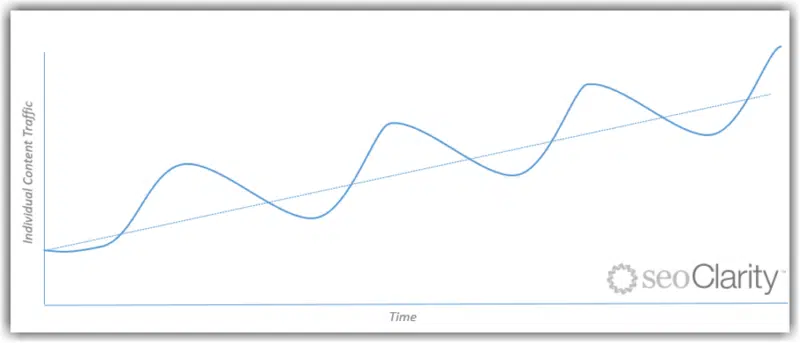
With the right framework in hand, content success becomes a consistent and repeatable process.
New content framework for predictable growth
We built this framework to help enterprises build a scalable process for driving predictable growth and ROI from their content marketing.
Here’s another look at content lifecycle with each stage labeled:
- Plant: Create content
- Seed: What questions is your audience asking?
- Grow: Expand visibility
- Feed: How do you optimize your content?
- Splice: What topic needs more depth?
- Decay: Update and optimize old content to secure your position
- Prune: What content is no longer relevant?
- Refresh: What content is decaying?
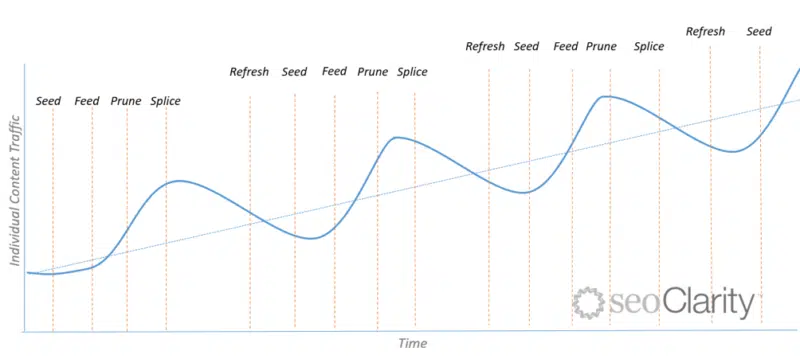
1. Plant: Create and publish
Seed
The volume of content created directly relates to the variety of audience needs you can address and your traffic opportunities.
You know that before you create content it’s important to understand your audience’s wants and needs, so be mindful of blind spots in your tool’s dataset.
Marketers use seoClarity’s Topic Explorer to understand audience demand months before these types of insights reach other tools. This allows them to identify high-value topics and uncover underlying searcher intent to then align their messaging with how their customers search for their products.
No matter which SEO research tool you choose, make sure it not only identifies phrase match (most do!) but also identifies queries that relate to searcher intent to truly understand how users search and how those audiences do or don’t overlap.
Another source of ideas comes from user questions. Marketers typically associate this content higher in the funnel. Google’s People Also Ask uncovers questions at all stages of the buyer’s journey. We’re proud to say that seoClarity has the largest People Also Ask dataset to give marketers access right from the source!
2. Grow: Expand coverage
Analyzing existing content is the next step to grow it further.
Use SEO segmentation to reveal patterns in performance. Understanding what Google picks up on will steer you to the next step: add to your content or expand it.
Feed
It’s all about tweaking and building your content to generate results faster.
The most impactful adjustments happen right when ranking data starts to populate.
Once you know what Google has found your content relevant for, evaluate whether it hit the intended mark.
Applying NLP processing and predictive analysis with content analysis and optimization tools accelerates this. These tools deliver insights to optimize exactly how the topic should be covered and what might need to be added or tweaked to be seen as authoritative.
Then, each piece of content needs to be fed with related content around the main pillar topic.
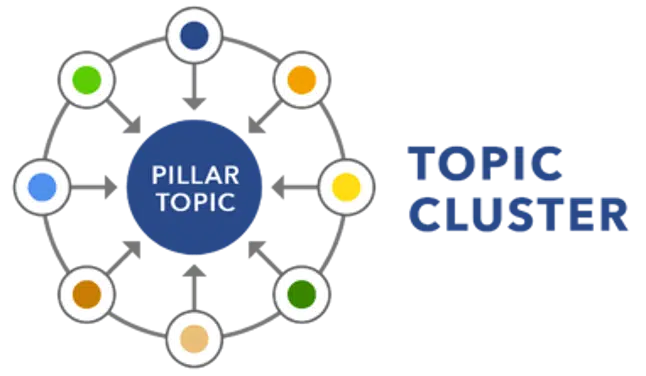
Creating topic clusters isn’t a new idea, but where the magic really comes in is the ability to match topics and uncover the vast ways users search.
The “secret sauce” that makes all of this work is to ensure your content matches the intent and covers the topic from all angles.
Here’s a quick example from seoClarity on the keyword “survival kit” — most tools generate lists that include:
- emergency kit, survival kit list, types of survival kits
Everything changes when you uncover related topics like those listed below, all in that same search:
- go bag, 72 hour kits, earthquake kit
Splice
Some content does so well that those pages are being overworked (i.e. one page ranks for hundreds, even thousands of keywords).
No single piece of content will stay relevant for too many keywords, but this offers the opportunity to leverage it for new pages.
This strategy also works to preempt any competitor from taking over your rankings and protect the rankings you’ve acquired.
A good rule to help narrow down pages to splice: look for pages that rank for 3x the number of keywords compared to the average.
Each site will have its own threshold for determining when to splice off content, but you can find your average by dividing your total ranking keywords by the total number of URLs that rank.
A way marketers do this is to look for patterns of keywords that are different. seoClarity’s Topic Explorer automatically surfaces the “patterns” underlying the keyword rankings for a page to help identify clusters of keywords that should have a separate piece of content targeting them.
Take the underperforming but relevant topics that this content ranks for and create new content centered around that sub-topic.
3. Refresh: Prevent decay
Prune
Oftentimes, enterprises have content that just goes wild over time. It either ranks for hundreds of keywords that it’s not relevant for, or the content itself is dead (it receives no impressions, clicks, backlinks, etc.).
Only the highest-quality content should stay on a site. Irrelevant or low-quality content decreases the crawl equity that’s distributed across the pages. Every marketer wants Google spending time crawling the best, freshest content.
Content to be pruned is either redundant, outdated, or trivial.
Redundant: duplicate content or keyword cannibalization
Outdated: content makes outdated references or content that has received no updates
Trivial: content that meets no performance metrics. One year from publish date is a safe window of time to remove content that isn’t performing.
To identify content to prune, check for pages that have been declining in traffic YoY and keywords with declining search volume over the last 24 months (keywords related to specific events or a specific year, for example).
Refresh
The goal here is to catch and refresh the decaying content before traffic hits zero.
Explore your site analytics to uncover pages that match one or more of the following criteria:
- Content that used to get traffic but lost its rankings
- Content that is shared heavily on social media but doesn’t rank
- Content that is within striking distance (positions 11-40)
- Content with high impressions but low CTR
Refresh the content when the data says to do so to avoid arbitrary projects that waste time.
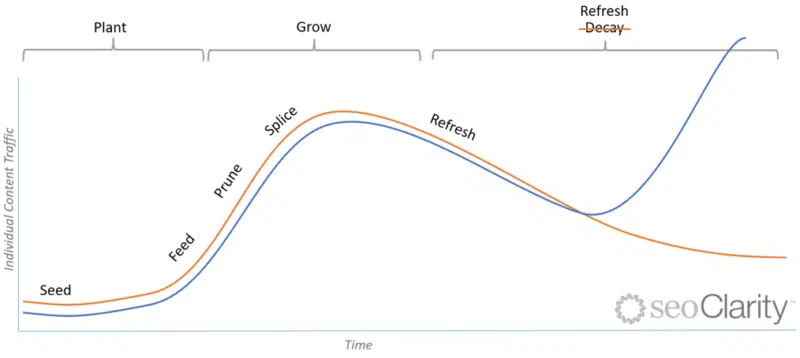
This isn’t keyword-to-keyword content optimization — we know we’re well beyond that now.
To have your content follow the blue trend line, identify the areas that are missing content based on how the audience, market, or competitors may have changed and updated content.
Tried and tested framework for content ROI
The content optimization framework has been refined and upgraded from three years of use by some of the highest-trafficked sites on the internet. In fact, here’s an example of an e-commerce delivery site that improved its CTR by 92%.
We applied data and performance at every step of the process to understand the results. Then, we created a way to do this at scale so marketers could mimic the growth and return.
If you’re looking for performance-driven content, seoClarity includes an all-in-one content optimization platform to deliver the insights required to answer every question along the content lifecycle, from what your audience searches for to identifying decaying content.
Related stories